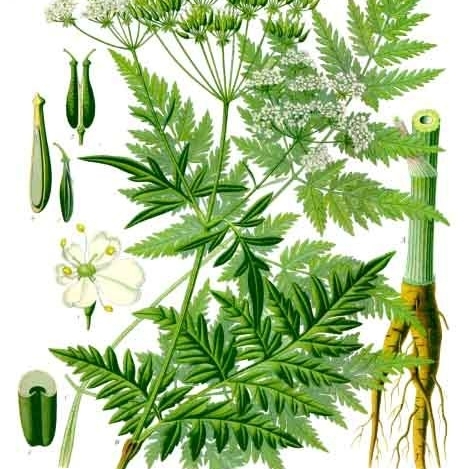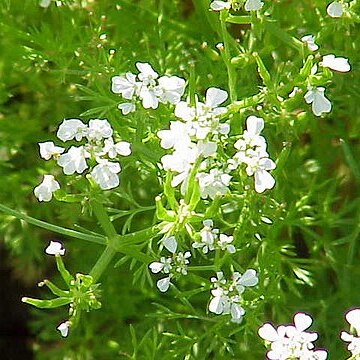Herbs, biennial or perennial. Taproot slender or thickened. Stem erect, branching and fistulose. Leaf blade 2–3-ternate-pinnate or pinnately decompound; ultimate segments dentate or pinnatifid. Umbels loosely compound, terminal and lateral; bracts absent; rays few, spreading; bracteoles several, margin ciliate, reflexed; pedicels spreading. Flowers polygamous. Calyx teeth obsolete. Petals white or yellowish green, oblong or cuneate with a narrow inflexed apex; outer occasionally enlarged (radiant). Stylopodium conic; styles short. Fruit long-ovoid to linear, apex attenuate into a beak, flattened laterally and often constricted at the commissure, smooth or bristly; ribs obsolete; vittae obscure to obsolete. Seed subterete in cross section, face deeply sulcate.
Fr ovoid to linear, laterally compressed, constricted at the commissure, distinctly beaked, the ribs obsolete, the oil-tubes obscure; carpophore entire or cleft at the tip; umbels compound, terminal (or lf-opposed) and from the upper axils, usually without invol; umbellets few-fld; bractlets ciliate or fimbriate, linear to ovate; sep obsolete; pet white; stylopodium conic; branching herbs with twice or thrice compound lvs and dentate to incised infls. 20, Eurasia.
Glabrous or hairy, annual, biennial or perennial herbs, with taproots. Lvs 2-4-pinnate; segments broad to narrow. Umbels compound, pedunculate; bracts few or 0, simple; bracteoles several, simple. Petals white or pink, regular or irregular, with apex notched and inflexed; calyx teeth small or 0. Fr. ovoid to linear, terete, usually tapering to beaked apex, usually spinous; commissure narrow; ribs inconspicuous, confined to beak; vittae solitary.


